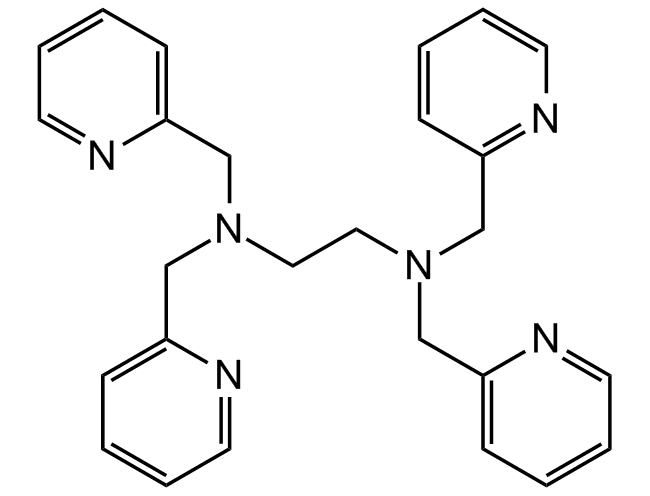
Chemical Structure
N,N,N,N-Tetrakis(2-pyridylmethyl)ethylenediamine
CDX-T0044
CAS Number16858-02-9
Product group Chemicals
Estimated Purity>95%
Molecular Weight424.5
Overview
- SupplierChemodex
- Product NameN,N,N,N-Tetrakis(2-pyridylmethyl)ethylenediamine
- Delivery Days Customer10
- CAS Number16858-02-9
- CertificationResearch Use Only
- Estimated Purity>95%
- Molecular FormulaC26H28N6
- Molecular Weight424.5
- Scientific DescriptionChemical. CAS: 16858-02-9. Formula: C26H28N6. MW: 424.5. TPEN is a cell permeable metal ion chelator. TPEN is a chelator that has a high affinity for zinc (Zn2+), next to other transition metals (Zn2+ >Fe2+ >Mn2+) and is used in zinc treatment studies to limit intra- and extracellular concentrations of the mineral. TPEN has lower affinity for Ca2+ and Mg2+ and can also form complexes with other soft metal ions such as Cd2+. In addition to a heavy metal chelator, TPEN is also known to be an apoptosis inducer. Depletion of zinc by TPEN induces apoptosis in several cell lines. TPEN shows anticancer activity through induction of caspase-dependent apoptosis, via reactive oxygen species (ROS) signaling mechanism and inhibiting cell autophagy. TPEN also inhibits RNA binding protein Lin28 and has been shown to be useful in extracting Abeta depostis from Alzheimers disease brain tissue. - TPEN is a cell permeable metal ion chelator. TPEN is a chelator that has a high affinity for zinc (Zn2+), next to other transition metals (Zn2+ >Fe2+ >Mn2+) and is used in zinc treatment studies to limit intra- and extracellular concentrations of the mineral. TPEN has lower affinity for Ca2+ and Mg2+ and can also form complexes with other soft metal ions such as Cd2+. In addition to a heavy metal chelator, TPEN is also known to be an apoptosis inducer. Depletion of zinc by TPEN induces apoptosis in several cell lines. TPEN shows anticancer activity through induction of caspase-dependent apoptosis, via reactive oxygen species (ROS) signaling mechanism and inhibiting cell autophagy. TPEN also inhibits RNA binding protein Lin28 and has been shown to be useful in extracting Abeta depostis from Alzheimers disease brain tissue.
- SMILESN(CC1=CC=CC=N1)(CC2=CC=CC=N2)CCN(CC3=NC=CC=C3)CC4=CC=CC=N4
- Storage Instruction-20°C,2°C to 8°C
- UNSPSC12352200


![TPEN [16858-02-9]](https://www.targetmol.com/group3/M00/35/70/CgoaEGayH1mEQxZzAAAAAJ4q0wo693.png)
